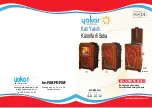
36
EN
DE
Actions to be taken in case of a chimney fire:
1.
Close the ash box, stove door and damper plate
(if installed).
2.
Contact local fire authority.
3.
Do not try to extinguish fire using water.
4.
After a sootfire, a chimney sweeper must check
the stove and the flue before use.
2.9. Troubleshooting
There is no draught in the flue. Smoke comes
into the sauna.
•
There are leaks in the flue connection. Seal the
connection ( 3.2.2.).
•
The brick flue is cold.
•
There is low pressure caused by an extractor fan
or another device in the room. Make sure there is
enough air to compensate.
•
Several fireplaces are used at the same time.
Make sure there is enough air to compensate.
•
The ash box is full.
•
The smoke canals of the stove are blocked ( 2.8.).
•
The flue connection pipe is too deep in the chimney
( 3.2.2.).
The sauna does not heat up.
•
The sauna is too big in relation to the stove’s
heating capacity (see table 1).
•
There is lots of non-insulated wall surface in the
sauna ( 1.).
•
The burning material is moist or its quality is
otherwise low ( 2.4.).
•
The flue does not have a good draught.
•
The smoke canals of the stove are blocked ( 2.8.).
The stove stones do not heat up.
•
The sauna is too small in relation to the stove’s
heating capacity ( 1.).
•
The flue does not have a good draught.
•
The burning material is moist or its quality is
otherwise low ( 2.4.)
•
The smoke canals of the stove are blocked ( 2.8.).
kann sich im Abzug Ruß ansammeln, der in
Brand geraten kann.
Im Falle eines Rußbrandes beachten Sie folgende
Anweisungen:
1.
Schließen Sie den Aschekasten, die Ofentür und
den Rauchabzug (soweit vorhanden).
2.
Kontaktieren Sie die örtliche Feuerwehr.
3.
Versuchen Sie nicht, den Rußbrand mit Wasser
zu löschen.
4.
Nach einem Rußbrand muss der Schorns-
teinfeger sowohl die Feuerstelle als auch den
Schornsteinabzug vor dem nächsten Anheizen
kontrollieren.
2.9. Störungen
Im Rauchfang findet kein Luftzug statt. Es tritt
Rauch in die Sauna.
•
Es gibt undichte Stellen im Anschluss des Rauch-
fangs. Dichten Sie den Anschluss ab ( 3.2.2.).
•
Der gemauerte Rauchfang ist kalt.
•
Ein Sauglüfter oder ein anderes Gerät im Raum
führt zu einem Niederdruck. Sorgen Sie im Aus-
gleich für genügend Luft.
•
Es werden mehrere Feuerstellen gleichzeitig
genutzt. Sorgen Sie im Ausgleich für genügend
Luft.
•
Der Aschekasten ist voll.
•
Die Rauchkanäle des Ofens sind verstopft ( 2.8.).
•
Das Abzugsanschlussrohr darf nicht zu weit in
den Rauchfang hineinreichen ( 3.2.2.).
Die Sauna wird nicht warm.
•
Die Sauna ist in Relation zur Heizkapazität des
Ofens zu groß (siehe Tabelle 1).
•
Es gibt viele nicht isolierte Wandoberflächen in
der Sauna ( 1.)
•
Das Brennmaterial ist feucht oder anderweitig
von schlechter Qualität ( 2.4.).
•
Der Rauchfang hat keinen guten Luftzug.
•
Die Rauchkanäle des Ofens sind verstopft ( 2.8.).
Die Saunaofensteine werden nicht warm.
•
Die Sauna ist in Relation zur Heizleistung des
Ofens zu klein ( 1.).
•
Der Rauchfang hat keinen guten Luftzug.
•
Das Brennmaterial ist feucht oder anderweitig
von schlechter Qualität ( 2.4.).
•
Die Rauchkanäle des Ofens sind verstopft ( 2.8.).
















































